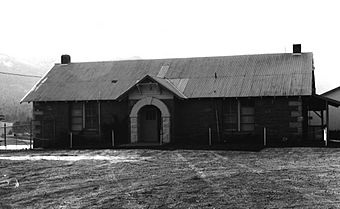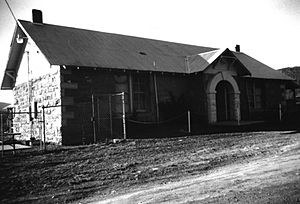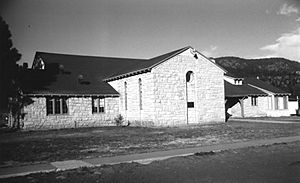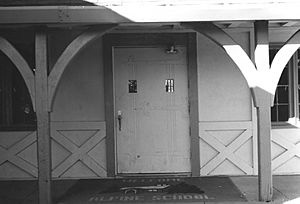Alpine Elementary School (Alpine, Arizona) facts for kids
Quick facts for kids |
|
|
Alpine Elementary School
|
|

School building
|
|
| Location | 11 and 12 Co. Rd. 2052, near jct. with US 180, Alpine, Arizona |
|---|---|
| Area | 2.5 acres (1.0 ha) |
| Built | 1930 |
| Architect | School - Unknown Chapel - Alexander & Burton |
| Architectural style | concrete foundation, limestone walls |
| NRHP reference No. | 97000369 |
| Added to NRHP | April 25, 1997 |
The Alpine Elementary School is a group of four buildings in Alpine, Arizona. It is run by the public Alpine Elementary School District. This school teaches students from kindergarten through 8th grade. The main school building was built in 1930. But there has been a school here since 1882!
The building now used as a gym and auditorium was once a church. It was built in 1939 for The Church of Jesus Christ of Latter-day Saints. Two newer buildings are modular (like pre-made sections). They are not part of the old, historic school. The school was added to the National Register of Historic Places in 1997.
Contents
A Look Back: School History
The school building you see today was built in 1930. It started as a two-room schoolhouse. But before that, there were four other school buildings!
The First Schools
The very first schoolhouse was built in 1882. It was made of logs and was 20 feet by 20 feet. In 1885, it was made bigger, becoming 40 feet by 20 feet. This log school was the only one in town for many years. Sadly, two students accidentally burned it down in the mid-1910s.
A second school was built in 1916-1917. It cost $4,000 and was made of wood. This school opened in the fall of 1917. It had two classrooms, a stage, and a recreation hall. It was big enough for 300 people, which was more than the whole town's population! In 1919, lightning struck the building. This caused a fire that burned the school to the ground.
A temporary school was quickly built in 1920. It was made of rough timber. All three of these early school buildings were used for more than just classes. They also hosted town meetings and church services.
The 1930 Schoolhouse
In 1930, the town spent $4,800 to build the current stone schoolhouse. It opened for classes that fall. The building had two classrooms and two cloakrooms. There were also two outhouses (outdoor toilets) behind the building. The school was built with a concrete foundation. Its walls were made of red limestone. This stone came from a quarry about three miles south of town.
One classroom was for grades 1 through 4. The other was for grades 5 through 8. During the 1930s, about 20 to 40 students attended the school. After finishing eighth grade, students who wanted to go to high school took a bus. They traveled about 20 miles north to Round Valley High School in Eagar.
During the 1930s, the schoolhouse was also the town's main meeting place. It hosted many different events and activities. It even served as the community's church for a while. In the 1940s, indoor restrooms and plumbing were added to the school.
The Chapel Becomes a Gym
As the town grew, the local church members felt they needed a proper chapel for worship. The building was designed by Alexander & Burton. Construction started in 1938. It was built by C. Bryant Whiting from nearby Springerville. The chapel was made of the same red limestone as the schoolhouse. Large stone blocks were dug up and brought to the site by horse-drawn wagons. Local workers, guided by an Italian stonemason, shaped the stones.
Wood for the inside came from US Forest Service lands. About 150,000 board-feet of wood were processed at a local sawmill. The fancy arches at the front entrance were made using a special saw. The chapel was finished on time in the spring of 1939. It cost less than $17,000. The first event held there was a meeting on April 30, 1939. Because it had a larger meeting room, the chapel took over from the schoolhouse as the main community and church center.
Some people say the two-room schoolhouse is the oldest school building in Apache County that has been used continuously. In 1972, the local church group was closed due to fewer members. In 1987, the public Alpine Elementary School District bought the former chapel. They connected it to the schoolhouse. Now, it is used as a multipurpose room and gymnasium. Besides school activities, the chapel still hosts community events and meetings.
School Buildings Today
The Alpine Elementary School complex has several buildings. There are two older stone buildings: the schoolhouse (built in 1930) and the former chapel (built in 1938–39). The chapel is now used as a gym and multipurpose room. Two newer, pre-made modular buildings were added in the mid to late 1970s.
The Main School Building
The school is a one-story building. It has a concrete foundation and red limestone walls. The corners of the building have white limestone blocks. The roof is made of galvanized sheet metal. There are two entrances, one on the east and one on the west. The main entrance is on the east. Both entrances have double wooden doors. Inside, there's a small entry area with stone pillars and concrete arches.
The schoolhouse doesn't have just one building style. You can see parts of the American Craftsman and Bungalow styles. These include the decorative wooden shingles under the roof, the three-light panel doors, and the knee braces. The rounded arches at the two entrances show a Romanesque Revival style.
Originally, the inside had two classrooms and a coatroom. In the 1940s, indoor plumbing and two restrooms were added. The classrooms are separated by a sliding wooden wall. The old wood-burning stoves used for heat have been replaced by central heating. We don't know who designed or built this school.
The Former Chapel (Now Gym)
The gymnasium is a one-and-a-half-story building. It has an interesting, uneven shape and a cross-gabled roof. Like the schoolhouse, it has a concrete foundation and a partial basement. It also has limestone walls, but this limestone is white, not red. Its roof is made of composition shingles.
The front of the building has a porch set back into the building. It is supported by wooden arches. The front door is made of solid wood planks with decorative iron hinges. You can see Stick style decorations at the front entrance and on the east and west ends of the roof. Other decorative touches include notched rafter ends and a dormer roof. Most of the windows are original metal casement windows with wooden frames. One window has been replaced with a modern aluminum one.
The chapel's original main room became the school's auditorium and gymnasium. The old floor was replaced with maple hardwood for a basketball court. The former church office was changed into a kindergarten room. Two smaller rooms were combined to make the home economics classroom. This room also serves as the school's cafeteria. An indoor restroom has also been added.
Alexander & Burton were the architects who designed the chapel. They designed several churches in the 1930s and 1940s. These include churches in Phoenix and St. Johns. C. Bryant Whiting, a contractor from Springerville, built the chapel. Its successful completion helped him become a very successful builder.
Other Buildings on Campus
Originally, there were two outhouses behind the school building. These were removed when indoor plumbing and restrooms were installed in the 1940s. Between 1976 and 1979, two pre-made modular buildings were added behind the schoolhouse. This was done to make more space for students. One of these modules holds the school's offices and a music room. The other contains the library and a learning center.






